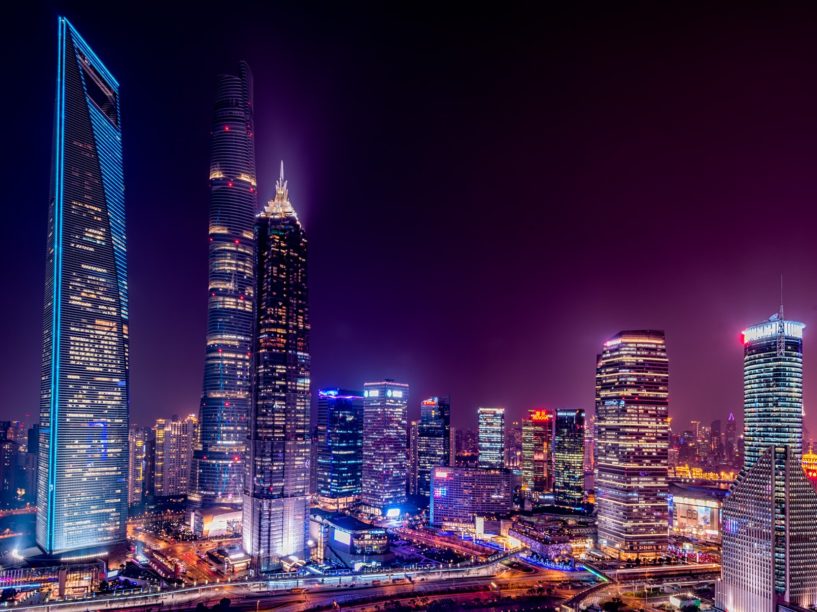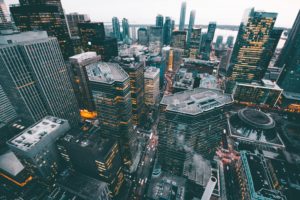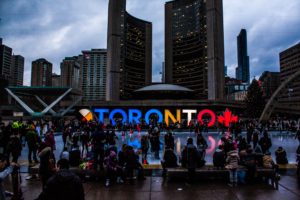
Smart cities are the cities of the future—but in some areas, smart cities are already here. By integrating web-enabled technology into urban infrastructure, modern metropolitan areas are improving economic efficiency, convenience, public safety, and environmental friendliness more than ever before. Going forward, tech industry experts predict this trend will only accelerate, driving economic growth in the tech sector.
 Some cities are much farther ahead in these innovations than others, but they do it through web-connected devices that are part of something known as the “Internet of Things,” or IoT, for which the benefits of web connectivity has become attainable even for objects that aren’t computers. As the IoT takes over cities across America, urban environments are being transformed in subtle and not-so-subtle ways.
Some cities are much farther ahead in these innovations than others, but they do it through web-connected devices that are part of something known as the “Internet of Things,” or IoT, for which the benefits of web connectivity has become attainable even for objects that aren’t computers. As the IoT takes over cities across America, urban environments are being transformed in subtle and not-so-subtle ways.
However, this re-imagining of urban life comes with challenges, such as requiring a drastic re-imagining of the power sources that run city infrastructure. Gadgets in the IoT are very efficient and require relatively little power to operate, but smart cities require many thousands of them: think street lamps that can detect gunshots, air quality sensors, and solar-powered traffic lights that can adjust automatically based on traffic volume.
For this reason, the most intelligent city will be the one that is most successful at finding economical and environmentally-sound ways to power all of these Wi-Fi enabled gadgets. Meanwhile, the city leaders and planners  who are best at navigating issues like energy consumption and network security are providing a flood of innovation that will create a blueprint; a smart city model that other cities can adopt.
who are best at navigating issues like energy consumption and network security are providing a flood of innovation that will create a blueprint; a smart city model that other cities can adopt.
For this post, we’ll look at some of the most advanced of the modern smart cities, and how their innovations are improving sustainability and managing all the environmental impacts and power demands of 21st-century urban development.
San Diego, California
 San Diego has done a great job at anticipating the high power need created by an increase in electric vehicles. With the popularity of plug-in cars surging in California, cities are finding that their power grids are strained by the more widespread use of vehicle charging stations. But a project at the San Diego Zoo is finding a solution.
San Diego has done a great job at anticipating the high power need created by an increase in electric vehicles. With the popularity of plug-in cars surging in California, cities are finding that their power grids are strained by the more widespread use of vehicle charging stations. But a project at the San Diego Zoo is finding a solution.
San Diego’s nearly year-round sunny weather makes solar technology a particularly attractive option for powering smart urban technology. And California’s love for EVs (electric vehicles) means there are lots of charging stations, all of which need to use lots of electricity. Government officials from The City of San Diego are working with giants like GE and the University of California to innovate a solution.
Enter a project dubbed Solar-to-EV. This initiative uses advanced solar “canopies” to provide the juice for EV charging stations at the San Diego Zoo. Any unused power the stations generate can then be sent back to the power grid and used by all. The canopies are for more expansive than traditional solar panels, providing enough electricity in full sunlight to power almost 60 small to average-sized homes.
Sometimes flat and sometimes curved, solar canopies are built over parking lots which can then accommodate large number of EVs. The canopies also provide shade to the cars, keeping them cooler and more comfortable – that diminishes the impulse for drivers to blast their A/C right away, making way for additional energy savings.
number of EVs. The canopies also provide shade to the cars, keeping them cooler and more comfortable – that diminishes the impulse for drivers to blast their A/C right away, making way for additional energy savings.
Toronto, Ontario
In recent years, electricity costs in the Toronto have surged. Costs have gotten so high that utility companies have even declared bankruptcy.
Thankfully, the city has eased the burden by getting smarter. Low-consumption LED streetlights have been installed that double as public Wi-Fi hotspots. The city can monitor these smart streetlights remotely, making it easy to manage them even when weather conditions become extreme.
 In Toronto, smart street lights are only the beginning. A Google-affiliated tech start-up called Sidewalk Labs is installing smart sensors in a particular neighborhood of Toronto to effectively turn the area into a testing ground for smart city technology. The sensors will collect data about air quality, noise levels, and even how many people are coming in and out of local buildings. This data collection process allows the sensors to communicate with smart technology built into city infrastructure, such as heated roads.
In Toronto, smart street lights are only the beginning. A Google-affiliated tech start-up called Sidewalk Labs is installing smart sensors in a particular neighborhood of Toronto to effectively turn the area into a testing ground for smart city technology. The sensors will collect data about air quality, noise levels, and even how many people are coming in and out of local buildings. This data collection process allows the sensors to communicate with smart technology built into city infrastructure, such as heated roads.
When sensors see that a blizzard has arrived, it might warm up the roads to melt the snow instead of spending on teams of fossil fuel-guzzling snowplow trucks and de-icers. By maximizing solar, wind, and other forms of renewable energy technology, the need for fossil fuels to run cities will continue to diminish.
Over time, the data that smart cities like Toronto collect can be used to design greener, more efficient spaces and  create more environmentally friendly approaches to city planning. It can also be used in the design of city-connected artificial intelligence that can help automate all of the smart city’s components.
create more environmentally friendly approaches to city planning. It can also be used in the design of city-connected artificial intelligence that can help automate all of the smart city’s components.
One thing is certain: the cities of the future will be planned from their inception with the assumption that, with the IoT, everything will be connected!
Highland Park, Michigan
For Highland Park, a suburb of Detroit, misfortune was turned into innovation. Changes in demographics and population led the city’s sewage and water utility systems to be forced to be integrated with Detroit’s, leading to massive increases in bills for city residents. The cost was simply too much for the city to handle without major cuts, so all the streetlights in town were taken off line and removed.
 Rather than stay in the dark, the people of Highland Park came together to fund resident-owned street lamps equipped with LED lighting technology. These new street lamps run completely independent of the city grid, removing them from the power consumption equation entirely.
Rather than stay in the dark, the people of Highland Park came together to fund resident-owned street lamps equipped with LED lighting technology. These new street lamps run completely independent of the city grid, removing them from the power consumption equation entirely.
They stay lit because of advances in solar technology and the low power need for LED lights, which use up to half as much power as the city’s previous grid-powered streetlights. They also stay on even when the grid goes down, keeping the city lit with energy-efficient battery packs that will keep powering the lights through utility outages.
Final Thoughts
As cities become smarter and power needs increase, innovation arrives to meet the demand. Entrepreneurs and their tech companies recognize this need, and are heeding the call with solutions that improve quality of life for people with smart buildings, smart public transportation, smart lighting, and other smart tech we haven’t even dreamed up yet.
Wherever the smart city movement takes us, urban planning—and life in the modern metropolis—will never be the  same.
same.
Latest Posts
March 4, 2020
February 27, 2020
CATEGORIES

